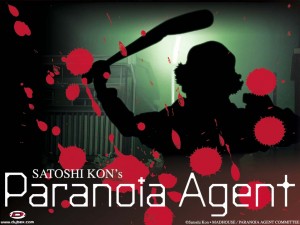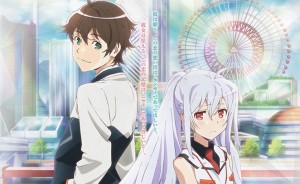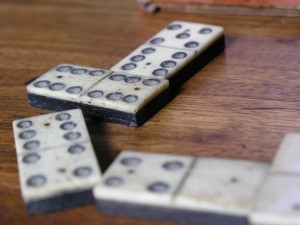“Paranoia Agent” – A Peek Into The Mind Of One Of Japan’s Greatest Directors
 When you ask somebody who’s not really all that interested into anime to cite a couple of anime films, the responses are always the same. “Akira”, “Ghost in the Shell”, “Spirited Away”… But a lot of people will also mention another movie by the name of “Paprika”. While most anime movies don’t receive a wide release outside of Japan, “Paprika” did, and it’s very easy to see why – its stellar animation, mindbending visuals and story that’s confusing in all the right ways made it a hit in Japan, and won it a moderate success outside of it, which is about as much as anime movies can enjoy, really. “Paprika” is a very interesting case within the anime industry because its director, Satoshi Kon, has never actually made a bad movie. Not only that – he’s never made anything that hasn’t been absolutely and completely stellar. From “Perfect Blue”, which inspired a generation of Hollywood directors, through the brilliant “Millennium Actress” which showed the world how a character-driven historical drama was supposed to be made, to the amazing “Tokyo Godfathers” which is, by far, the best Christmas movie I’ve ever seen despite coming from a culture that celebrates Christmas by eating lots of KFC. His movies could be terrifying, but they could also be quirky and hilarious when they wanted, but most importantly, they consistently pushed the boundaries of what could be done with anime and animation in general as a medium. Still, I believe that none of his works give us a better look inside Satoshi Kon’s mind than his first and only foray into serialized anime, “Paranoia Agent”.
When you ask somebody who’s not really all that interested into anime to cite a couple of anime films, the responses are always the same. “Akira”, “Ghost in the Shell”, “Spirited Away”… But a lot of people will also mention another movie by the name of “Paprika”. While most anime movies don’t receive a wide release outside of Japan, “Paprika” did, and it’s very easy to see why – its stellar animation, mindbending visuals and story that’s confusing in all the right ways made it a hit in Japan, and won it a moderate success outside of it, which is about as much as anime movies can enjoy, really. “Paprika” is a very interesting case within the anime industry because its director, Satoshi Kon, has never actually made a bad movie. Not only that – he’s never made anything that hasn’t been absolutely and completely stellar. From “Perfect Blue”, which inspired a generation of Hollywood directors, through the brilliant “Millennium Actress” which showed the world how a character-driven historical drama was supposed to be made, to the amazing “Tokyo Godfathers” which is, by far, the best Christmas movie I’ve ever seen despite coming from a culture that celebrates Christmas by eating lots of KFC. His movies could be terrifying, but they could also be quirky and hilarious when they wanted, but most importantly, they consistently pushed the boundaries of what could be done with anime and animation in general as a medium. Still, I believe that none of his works give us a better look inside Satoshi Kon’s mind than his first and only foray into serialized anime, “Paranoia Agent”.
While “Paranoia Agent” has a semblance of an overarching narrative, it is, for the most part, an anthology show. Characters cross over from story to story, giving the semblance of an interconnected world, and yet for the most part each episode revolves around a particular character and the struggles that they’re undergoing. The theme of the show is how our mind gives our problems physical form, manifesting them and causing us to confront them. Each character is plagued by something, be it guilt, regret or a feeling that’s a bit too complicated to describe in a single word, and the primary antagonist of the series is a creature that confronts them with their issues, allowing them to achieve catharsis in the most unusual way possible. At the heart of the story is a young woman named Tsukiko Sagi, who some time ago created a mascot character that has since taken Japan by storm. The character, a small pink dog named Maromi, appears on keychains, posters, toys, and even has his very own TV show. Pressured by everyone to repeat her success, Tsukiko starts looking for a way to escape… and finds it when, rather conveniently, a young boy on roller skates attacks her in a parking lot, giving her an excuse to take a few weeks off. Naturally, the detectives assigned to the case are skeptical of the existence of such an attacker, until a second victim reports being struck by a young boy on rollerskates. Then a third, a fourth and fifth. Little by little, hospitals start filling up with people who have been attacked by the mysterious boy (nicknamed “Lil’ Slugger” by the media), and as such have been allowed to escape their problems. Is this a mass psychosis, or is something a lot more demented and mysterious going on?
From what you just read you might be thinking that every episode is the same – “Oh, we’ve got a guy who has some sort of problem and deals with it during the episode until Lil’ Slugger comes and hits him on the head”. Yeah, well… No. Episodes are as varied as they would be on an anthology show, and while the theme of Lil’ Slugger and his influence connects them all, building up to a climax which brings Tsukiko back alongside several other characters in order to solve the mystery once and for all. In the middle of this all too delicious hamburger we’ve got the meat, which consists of stories that are as varied as they come, and the best part is that they’re not all about people with problems that Lil’ Slugger has to solve – some are about people with problems caused by Lil’ Slugger, while some only tangentially involve him. For example, one of the earlier episodes is about a young boy who matches the description of Lil’ Slugger, and the rumors start ruining his life. Another episode is solely about a couple of housewives gossiping about who, or what, Lil’ Slugger actually is, with each trying to one-up everyone else in order to relay the most shocking account of the events regardless of just how ridiculous they sound. My favorite episode is when the members of a chatroom decide to meet up in order to commit suicide together, except one of them turns out to be a little girl, so the whole episode becomes about them trying to bring her to the authorities while pretending to be searching for a suicide spot. It’s surreal, it’s bizarre, and yet it’s presented in such an amazingly intriguing way that you can’t help but be invested in it.
I really can’t talk in depth about the nature of “Paranoia Agent” without getting knees deep into spoilers territory, but suffice to say that you’re in for a ride! If you’re interested in checking out a crazy, creative semi-anthology series from one of the world’s greatest animators, then you owe it to yourself to give it a watch! It’s worth every second!

 For the next few blog posts, I decided to switch things up a bit on the blog! I’m usually talking about anime series from the 80s which are directly related to Saint Seiya, in some way, and by “directly related” I mean they’re Hokuto no Ken. Well, even though I’d never get sick of writing about Seiya and Hokuto, but I’m fairly certain you guys might get sick of reading about them if I don’t mix things up, so why don’t we fast forward a bit in the timeline and talk about some current anime that I’d recommend? At the end of the day, while 80s anime had a certain charm to it, anime from the last 10 years is also pretty darn great!
For the next few blog posts, I decided to switch things up a bit on the blog! I’m usually talking about anime series from the 80s which are directly related to Saint Seiya, in some way, and by “directly related” I mean they’re Hokuto no Ken. Well, even though I’d never get sick of writing about Seiya and Hokuto, but I’m fairly certain you guys might get sick of reading about them if I don’t mix things up, so why don’t we fast forward a bit in the timeline and talk about some current anime that I’d recommend? At the end of the day, while 80s anime had a certain charm to it, anime from the last 10 years is also pretty darn great! “Saint Seiya”, just like pretty much every huge anime franchise, has seen a ton of videogames based on it. Starting with “Saint Seiya: The Sanctuary” ten years ago on the now archaic PS2, the franchise has seen three more games based on it, with the latest, “Soldier’s Soul”, being released only a few months ago on the PS3, PS4 and, rather surprisingly, PC. While this may seem shocking, it’s really not – as I said, most big franchises of fighting anime have gotten plenty of games, including “Hokuto no Ken” (no, I’ll never stop talking about it on this blog, so sue me), “Bleach”, “Naruto”, “DragonBall” and so on and so forth. And admittedly, most licensed games haven’t been very good. Essentially, if you’ve played one of them, you’ve pretty much played all of them – they’re all 3D fighters with lots of flashy special attacks that play exactly the same way. “Ultimate Ninja Storm” is exactly like “Heat the Soul” which is exactly like “Dragonball Xenoverse”, minus a few differences.
“Saint Seiya”, just like pretty much every huge anime franchise, has seen a ton of videogames based on it. Starting with “Saint Seiya: The Sanctuary” ten years ago on the now archaic PS2, the franchise has seen three more games based on it, with the latest, “Soldier’s Soul”, being released only a few months ago on the PS3, PS4 and, rather surprisingly, PC. While this may seem shocking, it’s really not – as I said, most big franchises of fighting anime have gotten plenty of games, including “Hokuto no Ken” (no, I’ll never stop talking about it on this blog, so sue me), “Bleach”, “Naruto”, “DragonBall” and so on and so forth. And admittedly, most licensed games haven’t been very good. Essentially, if you’ve played one of them, you’ve pretty much played all of them – they’re all 3D fighters with lots of flashy special attacks that play exactly the same way. “Ultimate Ninja Storm” is exactly like “Heat the Soul” which is exactly like “Dragonball Xenoverse”, minus a few differences.